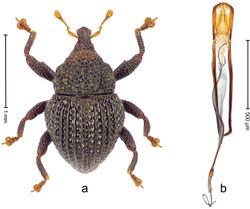Trigonopterus florensis
| Notice: | This page is derived from the original publication listed below, whose author(s) should always be credited. Further contributors may edit and improve the content of this page and, consequently, need to be credited as well (see page history). Any assessment of factual correctness requires a careful review of the original article as well as of subsequent contributions.
If you are uncertain whether your planned contribution is correct or not, we suggest that you use the associated discussion page instead of editing the page directly. This page should be cited as follows (rationale):
Citation formats to copy and paste
BibTeX: @article{Riedel2014ZooKeys, RIS/ Endnote: TY - JOUR Wikipedia/ Citizendium: <ref name="Riedel2014ZooKeys">{{Citation See also the citation download page at the journal. |
Ordo: Coleoptera
Familia: Curculionidae
Genus: Trigonopterus
Name
Trigonopterus florensis Riedel sp. n. – Wikispecies link – ZooBank link – Pensoft Profile
Diagnostic description
Holotype, male (Fig. 33a). Length 1.72 mm. Color of antennae and tarsi ferruginous, remainder black. Body in dorsal aspect with marked constriction between pronotum and elytron; with distinct constriction in profile. Rostrum with median ridge and pair of submedian ridges, anteriorly coarsely punctate-scabrous; epistome with transverse, subangulate ridge. Pronotum with subapical constriction; disk coarsely punctate-reticulate, sparsely setose; with pair of curved sublateral impressions; medially swollen. Elytra relatively compact; with striae deeply impressed, each with row of short suberect bristles; intervals costate, subglabrous; apex narrow, rounded. Femora each with small tooth. Metafemur subapically with stridulatory patch. Abdominal ventrite 5 coarsely punctate, with shallow median impression bordered by pair of weak longitudinal costae. Penis (Fig. 33b) with sides subparallel, in apical third markedly converging to narrow subglabrous apex; transfer apparatus flagelliform, 3.9 × as long as body; apodemes 3.5 × as long as body; ductus ejaculatorius torn and apical portion missing. Intraspecific variation. Length 1.48–2.04 mm. Color of elytra dark ferruginous to black. Female rostrum dorsally in apical half subglabrous, with submedian rows of sparse minute punctures, with dorsolateral pair of furrows; epistome simple. Pronotum in smaller specimens narrower, in large specimens wider. Elytra in larger specimens with humeri more distinctly subangularly projecting laterad, in smaller specimens evenly rounded; intervals weakly costate in smaller specimens, markedly costate or carinate in larger specimens. Penis with flagelliform transfer apparatus 3.9–4.0 × as long as body; apodemes 3.2–3.7 × as long as body.
Material examined
Holotype (MZB): ARC3618 (EMBL # LM656048), East Nusa Tenggara Prov., Flores, Ruteng, Mt. Ranaka, sample 1, S08°37.321', E120°31.463' 1535 m, 08-III-2011. Paratypes (MZB, SMNK, ZSM): Flores: 3 exx, ARC3616 (EMBL # LM656046), ARC3617 (EMBL # LM656047), ARC3619 (EMBL # LM656049), same data as holotype; 2 exx, ARC2189 (EMBL # LM655646), ARC2190 (EMBL # LM655647), Ruteng, Lake Ranamese, sample 1, S08°37.705', E120°33.702', 1320 m, 08-III-2011; 1 ex, ARC3621 (EMBL # LM656051), Ruteng, Lake Ranamese, sample 4, S08°37.705', E120°33.702', 1250 m, 08-III-2011; 2 exx, ARC2210 (EMBL # LM655666), ARC3620 (EMBL # LM656050), Ruteng, Golo Lusang, sample 1, S08°39.864', E120°27.322', 1590 m, 11-III-2011.
Distribution
East Nusa Tenggara Prov., Flores (Golo Lusang, Mt. Ranaka, Lake Ranamese). Elevation: 1250–1590 m.
Etymology
This epithet is based on the island of Flores.
Notes
Trigonopterus florensis Riedel, sp. n. was coded as “Trigonopterus sp. 440”. Morphologically it is very similar to Trigonopterus pseudoflorensis Riedel, sp. n. and Trigonopterus paraflorensis Riedel, sp. n. but its cox1 sequences differ 6.69%, respectively 7.75% smallest interspecific p-distance.
Original Description
- Riedel, A; Tänzler, R; Balke, M; Rahmadi, C; Suhardjono, Y; 2014: Ninety-eight new species of Trigonopterus weevils from Sundaland and the Lesser Sunda Islands ZooKeys, (467): 1-162. doi
Images
|
